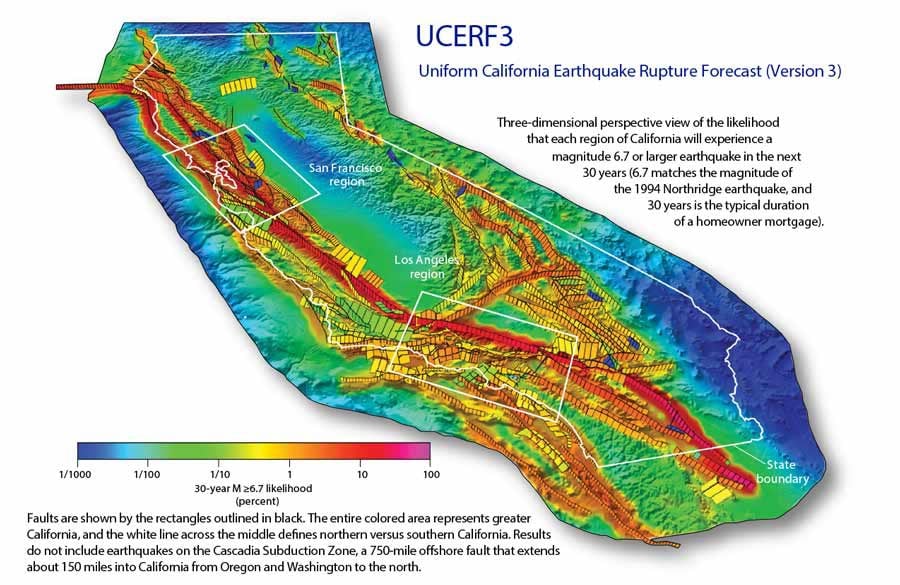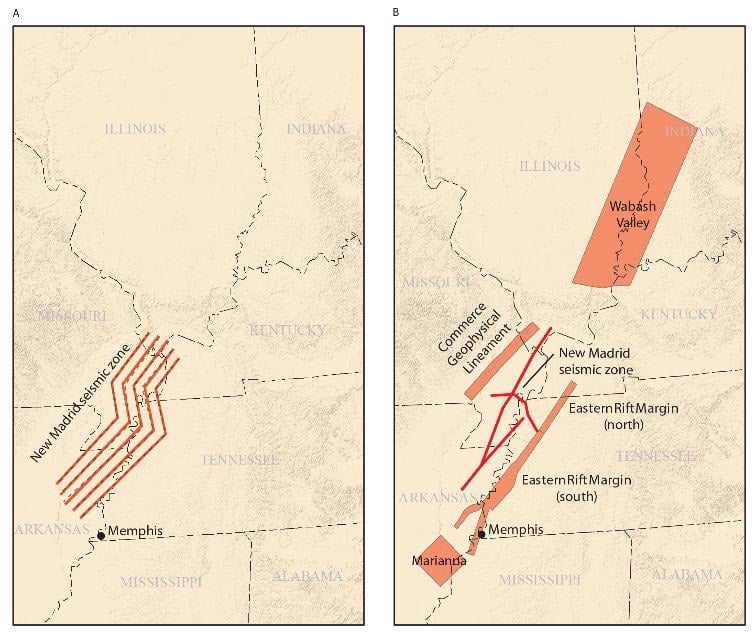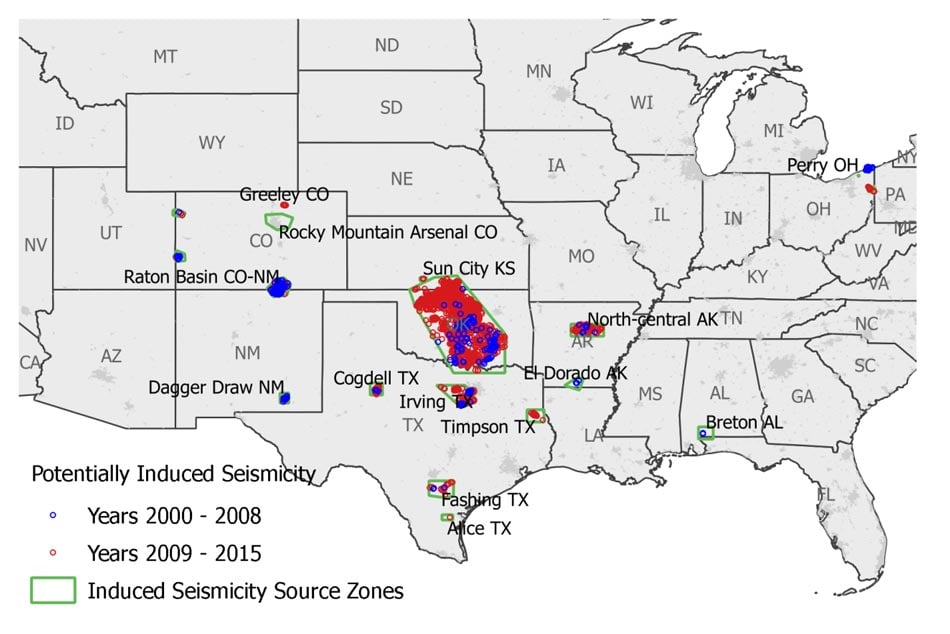Where in the Us Do We Find Faults That Are in Danger of Producing Earthquakes
Earthquake Risk in California
During the past century, seismicity in California has remained relatively low. However, the boundary of the Pacific and North America tectonic plates that form California's sleeping giant—the more than 1,200-km San Andreas Fault—has a 75% chance of producing an M7.0 quake or greater in the next 30 years, according to the United States Geological Survey. Along the San Andreas are regions of fault-locking that resist the northwestward movement of the Pacific Plate relative to the North American Plate; stress builds up until released by earthquakes. In the new maps, the USGS has determined that the probability of a major earthquake of M7.0 or greater has risen statewide; the chance of an ~M6.7 earthquake—a similar magnitude to the 1994 Northridge earthquake—in Southern California is now less likely by approximately 30%.1
Intensive models of California fault systems—including the San Andreas—have been captured in the third version of the Uniform California Earthquake Rupture Forecast (UCERF3) developed by the 2014 Working Group of California Earthquake Probabilities (WGCEP). The revised forecast (Figure 2) uses physical modeling more than its predecessor version (UCERF2), which relied more heavily on expert opinion, and its time-dependent model has been included as a key source for the updated AIR Earthquake Model for the United States.

UCERF3 also considers multi-fault rupture scenarios in which earthquakes are no longer confined to separate, individual faults but can rupture multiple faults and affect different locales simultaneously. UCERF2 also considered multi-segment faults. The difference between UCERF3 and UCERF2 is that UCERF3 got rid of the limiting concept of fault segments by defining all faults as a complex web of small segments (5–7 km in length) that can rupture in a complex manner. Thus UCERF3 created many more possible scenarios with complex rupture geometries and potentially larger magnitudes, including ruptures that can impact both Northern and Southern California. The inclusion of these multi-fault cascading ruptures—similar to those observed in many historical earthquakes (Table 1)—results in a portion of the built-up seismic energy being released by large magnitude events. The result is better agreement with historical earthquake rates for the state. (To learn more about cascading ruptures, please read this AIR Current about the Landers earthquake.)
| Year | Magnitude | Event | Faults Ruptured |
|---|---|---|---|
| 1987 | 5.9 | Whittier Narrows earthquake | Whittier Fault and the Puente Hills Fault system |
| 1992 | 7.3 | Landers earthquake | Johnson Valley, Landers, Homestead Valley, Emerson, and Camp Rock faults |
| 1999 | 7.2 | Hector Mine earthquake | Lavic Lake Fault and the middle section of the Bullion Fault; other nearby fault zones may have experienced some slip |
While UCERF2 considered about 10,000 fault-based rupture scenarios, UCERF3 addresses ~300,000. (To learn more about how UCERF3 was incorporated into AIR's updated earthquake model, please read this blog post.)
Earthquake Risk in the Pacific Northwest
The states of Washington and Oregon lie in the active crustal region of the Pacific Northwest (PNW), where significant earthquakes have occurred in recent history, including the 1993 M6.0 Klamath Falls earthquake in southern Oregon and the 2001 M6.8 Nisqually earthquake near Olympia, Washington—just 36 miles from Seattle. The maximum magnitude of background seismicity, magnitude-frequency distributions for fault sources, slip rate uncertainties, and dip uncertainties for normal faults for the region have been updated in the AIR U.S. earthquake model utilizing the data and methodologies employed by the USGS in their 2014 hazard maps. The USGS also employed physical models using both geologic and geodetic (e.g., GPS) combined-inversion data for constraining fault data for the first time in its 2014 update to account for uncertainty in activity rates on faults, which have been incorporated into the AIR model. In Washington, the Tacoma Fault was added and the South Whidbey Island Fault was updated.
Within the PNW, the Cascadia Subduction Zone (CSZ)—a very long (1,000 km) plate boundary capable of producing large earthquakes (up to ~M9.0)—lies directly offshore. Earthquake rupture geometries and rates based on published research have been incorporated into the AIR model. An updated stochastic catalog for deep subduction earthquakes, which are especially common in the Puget Sound region, is also available.
Earthquake Risk in the New Madrid Seismic Zone
The New Madrid Seismic Zone (NMSZ) in the Central United States, comprising Arkansas, Illinois, Indiana, Kentucky, Missouri, Ohio, and Tennessee, also has the potential to produce large, destructive quakes—as it did in the winter of 1811-1812. Recent research that re-examined intensity data and physical models suggests M6.8–8.0 events are possible, and even larger earthquakes may occur on the central and southern segments of the fault zone. The rupture geometry, magnitudes, and return periods of events for the NMSZ have been updated in the upcoming model using USGS data and published research.
The USGS update also included new repeating large magnitude earthquake sources (M6.9–7.9) from the Central and Eastern United States Seismic Source Characterization for Nuclear Facilities ( CEUS - SSC ) Project for the NMSZ, which have been incorporated in the AIR model: the Wabash Valley Fault System, the Commerce geophysical lineament, the Eastern Rift Margin, the Marianna Fault, and the Arkansas–Kentucky New Madrid fault source (Figure 3).

Consideration of Induced Seismicity
The stable, continental region of the Central United States has seen an uptick in earthquakes due to induced seismicity (seismic events resulting from human activity), including the 2016 M5.8 earthquake in Pawnee, Oklahoma; the 2011 M5.0–5.7earthquake sequence in Prague, Oklahoma; the 2011 M5.3 earthquake in Trinidad, Colorado; the 2011 M4.7 earthquake in Guy-Greenbrier, Arkansas; and the 2012 M4.8 earthquake in Timpson, Texas. The new induced seismicity catalog for the Central and Eastern United States—available in the updated U.S. earthquake model—covers USGS-defined "induced seismicity source zones" with a focus on Oklahoma, Kansas, Colorado, New Mexico, Arkansas, and Texas (Figure 4). The catalog integrates the latest data and scientific opinion put forth in the USGS 2016 One-Year Seismic Hazard Forecast with research conducted by AIR scientists to address additional uncertainties beyond the USGS formulation, and thus provides a robust view of induced seismicity risk. The induced seismicity catalog can either be merged with the standard earthquake catalog or not; it is easily turned on and off.

Calculating Ground Motion Across the U.S.
The various tectonic settings that comprise the U.S. are reflected in the new suite of ground motion prediction equations (GMPEs) implemented in the 2017 model update for U.S. earthquake to provide more realistic ground motion simulation. Using the same methodology employed by the USGS in the 2014 National Seismic Hazard Map update (i.e., logic tree or weighted scheme), the GMPEs are combined to calculate the spectral acceleration and peak ground acceleration—the movement experienced by a structure—at each site. Updates include the work of the NGA-West2 project2 to characterize ground motion behavior in active crustal tectonic regimes and model site amplification factors. New research on ground motion behavior of induced earthquakes has also been incorporated.3
The model's GMPEs include adjustments to explicitly account for the effects of local site amplification from alluvial deposits—loose gravel, sand, silt, or clay left by moving bodies of water—that are known to amplify some earthquakes. Accordingly, soil maps for California have also been updated to the latest available data representing shear wave velocities in the top 30 meters (i.e., Vs30 data).
Newly Added: Tsunami and Landslide Sub-Perils
As part of the seismically active Pacific Ring of Fire, with tectonic sources along the Cascadia Subduction Zone (CSZ) and Alaska Trench, the West Coast of the U.S. is exposed to various tsunami sources. Of particular concern is the density of coastal exposures, including the many ports, marine facilities, large population centers, and businesses; California alone has 11 cargo seaports and 27 small craft harbors supporting more than 500,000 jobs statewide and USD 30.5 billion in personal income. The area has drawn concern in recent years because of new research suggesting increased frequency of large earthquakes in CSZ and shortened forecast periods for its next potential large magnitude quake. (To learn more about seismic risk in CSZ, please read this AIR Current.)
The updated U.S. earthquake model features tsunami as a new sub-peril for the West Coast and the CSZ. AIR scientists and engineers developed the tsunami module by enhancing the TUNAMI model—a numerical model that incorporates geographic data to determine the physical characteristics and propagation of a tsunami—to capture the complex nature of a tsunami's development and behavior as it nears land and comes ashore; fluctuations of astronomical tides are also considered.
While the risk of tsunami mainly affects the West Coast, the risk of earthquake-triggered landslide impacts the entire country. A major geologic hazard frequently triggered by strong ground motion, landslides can cause destruction of buildings, roads, power lines, pipelines and other exposures; in some locations, these losses can exceed those caused by ground shaking and fault rupture. Newly supported in the updated U.S. earthquake model is a landslide module that incorporates Digital Elevation Model (DEM), geological, and precipitation data to capture the damaging effects of earthquake-triggered landslides for the contiguous United States.
Conclusion
As science and technology advance, new research provides an updated view of earthquakes and related sub-perils, and how those hazards interact with our world. To continue providing the most comprehensive and robust risk management solutions, AIR incorporated the latest scientific findings for earthquakes into the updated AIR Earthquake Model for the United States.
Where in the Us Do We Find Faults That Are in Danger of Producing Earthquakes
Source: https://www.air-worldwide.com/publications/air-currents/2017/Earthquake-Risk-in-the-United-States--A-Major-Model-Update/
0 Response to "Where in the Us Do We Find Faults That Are in Danger of Producing Earthquakes"
Post a Comment